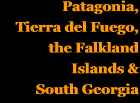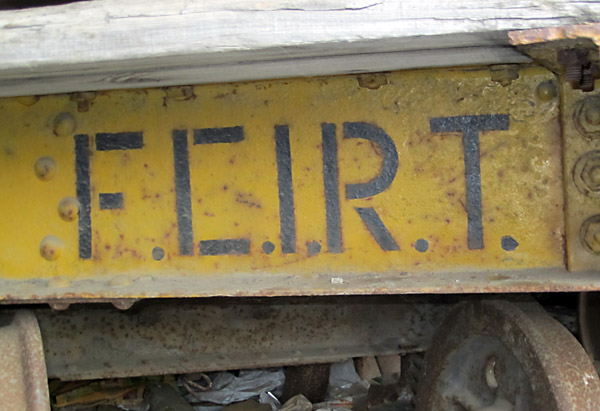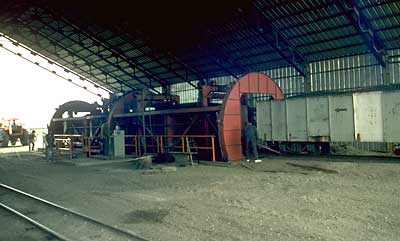 |
||||||||||||||
 |
||||||||||||||
 |
||||||||||||||
 |
||||||||||||||
More recent changes For many years the railway ran without any attention from the outside world. Coal was obviously the main traffic, but there were also passenger coaches and diesel railcars for mine staff. A description of the line's operating procedures is given on a separate page. By the 1970s, however, the idea of a 75cm. railway running trains of 1000 tons plus attracted increasing numbers of enthusiasts. However, there were warning clouds building up. It had always been difficult to find sufficient customers for Río Turbio coal, and in fact a big stockpile had been built up in the hope that new buyers would eventually appear. For many years this did not matter, for the YCF as a nationalised industry was not obliged to be profitable. As an example, in the mid 1970s roughly 500,000 tonnes of coal per annum was sold whilst anything up to 1,500,000 tonnes had actually been produced. In fact YCF by then was making more than half of its income from the sale of 'petroleum coke' produced by YPF from its wells in Neuquén, Patagonia and Tierra del Fuego. This whole scenario had led to an atmosphere of complacency throughout the organisation, epitomised by there being 3,000 office workers as compared to 1,300 miners in Río Turbio! However, Argentina, in common with many other countries, was increasingly turning to oil and gas for its energy. Winds of privatization were already blowing through other industries such as the state railways and petroleum. In 1988 YCF gave up running its own shipping fleet, and in an idiosyncratic and fairly meaningless gesture the railway altered its name to the Ferrocarril Industrial Río Turbio, a change easily made by just deleting the initial 'R' from RFIRT, though there were alternatives as the photo below illustrates.
Then in 1994 came privatization of the mine and railway. In fact the government would probably have liked to close the mine completely, but could not face the political consequences, so like many governments elsewhere, they decided to off load the unpopularity onto others. A ten year concession to run both mine and railway was announced, to a consortium to be known as the Yacimiento Carboniferos Río Turbio SA or YCRT. The nature of this arrangement can be gathered from the annual subsidy of $US22,5M and the obligation on the operator of the San Nicolás power station to buy Río Turbio coal at well over market price for the ten years! There were instant changes. The mine replaced its hundreds of tub wagons with a conveyor belt system, and the railway its twenty steam engines with four ex-Bulgarian State Railways diesels. As Sergio Garcia commented in his comprehensive article in the Todo Trenes magazine in 2009 (1), this did not just reflect improved efficiency but more importantly the vast reduction in the traffic being carried. There was a lot of comment in the enthusiast press about an efficient fleet of steam locos being laid aside, but the practical reality was that spare parts were difficult to find and steam crews and fitters difficult to recruit. The one positive step was the construction of a new port at Punta Loyola south-east of Río Gallegos, necessitating the building of a new branch line. Punta Loyola had been suggested as the railway's coastal terminus back in 1950, for the water depth can cope with ships of 25,000 tonnes rather than the 10,000 tonnes of Rio Gallegos. At that stage however, the decision had been made to avoid the extra track mileage needed to reach Punta Loyola. A new bridge on the branch, over the río Chico, utilises a span rescued from the closed broad gauge line out of Comodoro Rivadavia. Punta Loyola is also notable for its wreck of an iron sailing ship, the Marjory Glen , illustrated in an appendix page.
This photo shows the wagon tippler at Punta Loyola (5). On the extreme left is the tractor which pulls short rakes of wagons onto the tippler. As the railway does not use rotating couplers each wagon must be uncoupled before tipping. In the years after the new port came into operation, the original route to Río Gallegos initially declined in importance and was then closed. All railway maintenance is now concentrated at Río Turbio and the workshops in Río Gallegos have been closed and the site cleared. The best of the steam locos, and other useful stock, were moved to the western end of the line where vandalism is less likely, and by 2011 the remaining derelict locos and wagons had been concentrated in a small compound adjacent to the Ferro-aficionados club-house. With hindsight the YCRT was not trying to maximise business and turnover, but merely to minimise costs. The inevitable result was the run-down of skills, maintenance and the state of the equipment. By the year 2000 the railway was characterised as being merely a linear scrapyard, with just one train a week. There was also a serious accident in the mine, with fourteen miners losing their lives. This had not gone un-noticed. In 2002 the government rescinded the concession and took back the operation of the mine and railway, prompted finally by the San Nicolás power station operators breaking their contract and starting to import coal from South Africa. The long term future of of the mine is still not certain, but initial moves have been encouraging. Further diesels have arrived from Bulgaria; new wagons have been ordered, and even a pair of new passenger coaches. Restored steam? Suddenly at the end of 2014, things started to happen, when it was announced in the press (2) that work would be starting on refurbishment of stock for a proposed tourist railway, we were decidedly sceptical until views appeared showing the remains of the old Familleureux coaches being loaded for transport to Trevelin for reconstruction. (2A) Likewise our disbelief in the restoration of two engines was proved to be unfounded with the publication of photos of the engines in Buenos Aires where they were to be restored. (3)
These two photos relating to the refurbishment of the two RFIRT locos in Buenos Aires show the confined space in which the work was carried out. (4)
In March 2015, one of the engines had been stripped down to basic components – here are the frames. (5)
And here the naked boiler. (5)
The locomotive was dismantled into its myriad parts. (6) This is the stoker motor under overhaul.
Interestingly the Argentine made pressure gauge displays the pressure both in lb / in2 and kg / cm2. (6)
A new completely all-welded cab has been provided. (7)
It is wooden lined on the inside. (8)
Once completed the locomotive was hoisted up into the air and the low loader trailer carefully slid underneath it. (9)
With the ousting of the Kirchner dynasty at the presidential elections at the end of 2015, there was a decided change in emphasis on public spending. However one locomotive, three coaches and a furgón were completed and returned to the line before this happened. What will happen to the other engine is anyone's guess. The material was returned to El Turbio station as there is a main road nearby and solid access alongside the line. Here N° 119 sits on the low loader on which it came down from Buenos Aires. (10)
The tender came on a second low loader. The initials on the tender are a throw back to the very early days of the line. But the expansion of the initials is new. (10)
The coaches were in a sorry state when they were lying at Río Turbio.
It is perhaps a tribute to the original design and workmanship that the coaches were able to withstand the handling needed to get them loaded on to the lorries.
The Facebook page of G y G Metalmecánica, who were the main contractors for the work, then published this view of one of the coaches in a trifle cramped joiner's workshop in Trevelin. (11)
The first thing done was to dismantle them back to the framing. (12)
Once completed with planking inside and with re-upholstered leather seats — yes this is first class — they looked a whole lot better.
This is the interior of one of the refurbished coaches, complete with the essential salamandra, which in deference to modern views on safety is provided with mesh guards. (13)
The furgón was stripped right back to its framing. (14)
The following detail views of the furgón were taken near the end of its refurbishment. The colour is red overall with black surrounds to the windows. It too is provided with a name plate.
At one end inside it is provided with a fixed messing table and in the background next to the end bulkhead is the salamandra for heating, but absolutely essential for boiling the kettle of water for the maté.
Looking in the opposite direction we see the first aid cabinet, with a folded stretcher attached to the wall and on the end bulkhead a fire extinguisher. The varnished door to the right leads in to the toilet compartment. (15)
Along the outside wall of the two duckets is a wooden bench.
At one end (the one with the toilet) there is a separate workshop compartment accessible from within, but also with a large external sliding door on one side. Under the work bench there is a small generator to provide mains power.
The complete train was exhibited at Killik Aike Sur station, named after the nearby estancia. This is a new “station” located where Ruta 3 crosses the line on its way to Puerto Loyola; it consists of a concrete platform and a name board somewhat propped up. There is also a triangle provided for turning trains. It should not be confused with estancia Killik Aike Norte, which lies on the opposite side of the estuary and was at one time served by a 60 cm gravity operated line for its wool exports. (16)
This is the complete tourist train comprising three refurbished Familleureux coaches and a furgón de cola with very wide duckets. (17) The coaches are in a smart dark green livery with a central name plate above a small YCF roundel. It may be considered that some of the infrastructure is already in place for such traffic. There is already a modern station building at Río Turbio. The upper floor gives a clear view over the yard. The ground floor window to the right is the station master's office and the area under the second storey is a general waiting room. The modern toilets are hidden at the rear of the station. Unsurprisingly the only thing lacking for a passenger station is a booking office. There is even a modern sign advertising the presence of the station behind the trees. In connection with the proposed tourist activities, there has been talk of relaying the line back into Río Gallegos. A study of Google earth shows that the formation has been converted into a road from the point where it used to cross Ruta 3 to the old end of the line. From there out to Empalme Km 9 the formation is largely intact. What hasn't appeared in the press is the fact that a major railway contracting firm EDIMAT has been undertaking two contracts for the provision of two 6 km lengths of new railway between Killik Aike Sur and Río Gallegos The client for this work is Fundación Facultad Regional Santa Cruz. Following this up on the web it turns out that this is part of the Universidad Tecnológica Nacional. On the contractor's web site there is an aerial view of a new formation with the track laid and another at ground level looking back along a new formation on which track is being laid. To the right there is the suggestion of a curved formation heading away which suggests that this might be at the site of the old Empalme Km 9.
References: 11-2-2018 |
||||||||||||||
Main pages
Appendices
Chapter 9
Coal railways including the RFIRT





























